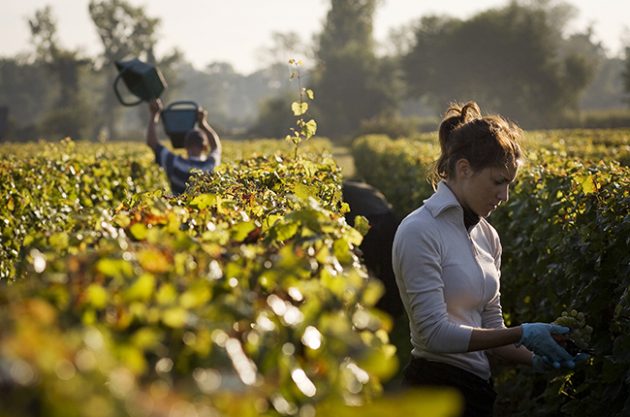John Salvi MW takes us through the highs and lows of the Bordeaux 2015 vintage. He uses his 30 years of professional experience to give the highlights of structure and expression in this particularly promising year...
Two Perceptive Comments By Great Winemakers
I would like to start with the highly perceptive summing up of the 2015 vintage made by the late and much-loved Paul Pontallier of Château Margaux shortly before his death earlier this year:
“August saved the vintage, September and October made it”.
WHY? The very cool weather and intermittent rain in August revitalised the vines after the fierce heat and hydric stress of July and the fine September and October weather permitted picking perfect, fully ripe grapes under ideal conditions.
The second quote comes from the recently promoted Charles Chevallier of Château Lafite:
“When the grapes are ripe do not wait – Pick them”.
WHY? If the grapes become even fractionally overripe the acidity decreases and the resultant wines lack freshness and crispness.

Chateau La Mission Haut-Brion
Alcohol
One of the most positive features of the vintage. With the perfectly ripe grapes one might have expected more sugar in the must, but with a few exceptions this was not the case and alcohol levels were under 14th???. The highest was La Mission Haut Brion, exceptionally, at 15.1°. Naturally, picking early helped keep alcohol levels modest and strangely enough sugar content in the grapes increased very little during the last days before picking, helped by cool nights.
Tannins
Tannins are always one of the most important elements in any red wine. They are vital for its structure, and together with acidity, to its ageing potential. These are the two elements that enable a wine to enjoy a long life. This year many winemakers said they had rarely seen such perfect tannins. 2015 was a vintage in which gentleness was of vital importance. Tannins were liberated quickly during the fermentation as soon as alcohol was present to dissolve them. Fermentation temperatures needed to be kept low (maximum 28°C) and post fermentation maceration kept reasonably short.
Colour
This of course goes hand in hand with tannins as it is these polyphenols which provide it. Because of the tannin ripeness in 2015, colour came out of the skins quickly and because of the thick skins of the berries there was plenty of it. The resultant colours were deep, intense and purple.

Château Angelus, St-Emilion
Acidities
This was the one weak point of 2015 – the one flaw? Great winemakers avoided the trap but many fell into it. The weather was so fine, the grapes so healthy and conditions so perfect that many felt that they could wait with no danger of rot – a situation rare in Bordeaux. Even waiting a fraction too long meant that although the grapes remained healthy the acidities decreased below optimum levels with the result that the wines lost freshness and vitality and became a trifle flat. Perfect acidities with ripe tannins were the ideal for the great wines.
Fruit
Perhaps the biggest plus of the 2015 vintage. All great winemakers agree that 80% of great wine is made in the vineyards. In Bordeaux, with our humid climate, it is rare to have perfectly ripe and still perfectly healthy grapes right up to the end of the vintage. By perfect ripeness I mean optimum ripeness and not maximum ripeness. The fruit therefore was pure, crystalline and full of flavour and fragrance.
Rot
There was virtually no rot or mildew on the grapes in 2015. A rarity in Bordeaux and an essential criterion for great wine.

Château Latour-Martillac harvest
Structure
A perfectly structured wine is one in which all the elements are in balance and blend together to make a harmonious whole – predominantly alcohols, tannins and acids. This is essential for laying down and long-term enjoyment as well as investment. 2015 meets these criteria to the full!
Dry White Wines
It was an early vintage, which proved important. Grapes were ripe and in perfect health and acidities were still at optimum levels. The best wines are aromatic, wonderfully crisp, fresh, energetic, mineral and full flavoured. Here there are some delicious little lesser known wines to be discovered.
Sweet White Wines
A great year for the finest. 2015 was the third earliest vintage in the history of Château d’Yquem. It started on 3rd September and was all over by 21st October. Intermittent, but perfectly timed rains brought on massive botrytis, which this year was wonderfully pure and concentrated and completely untainted by grey or acid rot. Sweet white wines from 2015 will provide relatively early drinking and can be considered as a “pleasure” vintage.

Botrytis Cinerea
Conclusion
A more than fine vintage; in the hands of the best winemakers it was superb and in the hands of the artists it was truly great! As noted the main fault of the vintage was picking too late and the resultant slight lack of acidity and freshness. Generally though, 2015 has provided fine-balanced, deep-fruited red wines, superbly crisp dry white wines and airy yet liquorous sweet white wines. As usual buyers should use their judgement and not rely on names and reputations!







